I'm working with custom drawing / 2D animation and I'm trying to figure out how to detect when the moving object collides with a wall in the map. User holds arrow keys on the keyboard to move the object, and the map is stored as an array structure of points. The walls in the map may be angled, but no curved walls.
Using the map structure (FMap: TMap;) in my code below, in the DoMove property, how do I detect if the object is colliding with any wall in the map and prevent it from moving through? In DoMove, I need to read FMap (refer to DrawMap to see how FMap works) and somehow determine if the object is approaching any wall and stop it.
I could do a dual X/Y loop iterating every possible pixel between each two points in each part of each map, but I already know this will be heavy, considering this procedure will be called rapidly so long as the object is moving.
I thought of reading the pixel colors in the direction the object's moving, and if there's any black (from map lines), consider it a wall. But eventually there will be more custom drawing of a background, so reading pixel colors wouldn't work.

uMain.pas
unit uMain;
interface
uses
Winapi.Windows, Winapi.Messages,
System.SysUtils, System.Variants, System.Classes,
Vcl.Graphics, Vcl.Controls, Vcl.Forms, Vcl.Dialogs, Vcl.ExtCtrls;
const
//Window client size
MAP_WIDTH = 500;
MAP_HEIGHT = 500;
type
TKeyStates = Array[0..255] of Bool;
TPoints = Array of TPoint;
TMap = Array of TPoints;
TForm1 = class(TForm)
Tmr: TTimer;
procedure FormKeyDown(Sender: TObject; var Key: Word; Shift: TShiftState);
procedure FormKeyUp(Sender: TObject; var Key: Word; Shift: TShiftState);
procedure TmrTimer(Sender: TObject);
procedure FormCreate(Sender: TObject);
procedure FormDestroy(Sender: TObject);
procedure FormPaint(Sender: TObject);
private
FBMain: TBitmap; //Main rendering image
FBMap: TBitmap; //Map image
FBObj: TBitmap; //Object image
FKeys: TKeyStates; //Keyboard states
FPos: TPoint; //Current object position
FMap: TMap; //Map line structure
procedure Render;
procedure DrawObj;
procedure DoMove;
procedure DrawMap;
procedure LoadMap;
public
end;
var
Form1: TForm1;
implementation
{$R *.dfm}
uses
Math, StrUtils;
procedure TForm1.FormCreate(Sender: TObject);
begin
FBMain:= TBitmap.Create;
FBMap:= TBitmap.Create;
FBObj:= TBitmap.Create;
ClientWidth:= MAP_WIDTH;
ClientHeight:= MAP_HEIGHT;
FBMain.Width:= MAP_WIDTH;
FBMain.Height:= MAP_HEIGHT;
FBMap.Width:= MAP_WIDTH;
FBMap.Height:= MAP_HEIGHT;
FBObj.Width:= MAP_WIDTH;
FBObj.Height:= MAP_HEIGHT;
FBObj.TransparentColor:= clWhite;
FBObj.Transparent:= True;
FPos:= Point(150, 150);
LoadMap; //Load map lines into array structure
DrawMap; //Draw map lines to map image only once
Tmr.Enabled:= True;
end;
procedure TForm1.FormDestroy(Sender: TObject);
begin
Tmr.Enabled:= False;
FBMain.Free;
FBMap.Free;
FBObj.Free;
end;
procedure TForm1.LoadMap;
begin
SetLength(FMap, 1); //Just one object on map
//Triangle
SetLength(FMap[0], 4); //4 points total
FMap[0][0]:= Point(250, 100);
FMap[0][1]:= Point(250, 400);
FMap[0][2]:= Point(100, 400);
FMap[0][3]:= Point(250, 100);
end;
procedure TForm1.FormKeyDown(Sender: TObject; var Key: Word;
Shift: TShiftState);
begin
FKeys[Key]:= True;
end;
procedure TForm1.FormKeyUp(Sender: TObject; var Key: Word; Shift: TShiftState);
begin
FKeys[Key]:= False;
end;
procedure TForm1.FormPaint(Sender: TObject);
begin
Canvas.Draw(0, 0, FBMain); //Just draw rendered image to form
end;
procedure TForm1.DoMove;
const
SPD = 3; //Speed (pixels per movement)
var
X, Y: Integer;
P: TPoints;
begin
//How to keep object from passing through map walls?
if FKeys[VK_LEFT] then begin
//Check if there's a wall on the left
FPos.X:= FPos.X - SPD;
end;
if FKeys[VK_RIGHT] then begin
//Check if there's a wall on the right
FPos.X:= FPos.X + SPD;
end;
if FKeys[VK_UP] then begin
//Check if there's a wall on the top
FPos.Y:= FPos.Y - SPD;
end;
if FKeys[VK_DOWN] then begin
//Check if there's a wall on the bottom
FPos.Y:= FPos.Y + SPD;
end;
end;
procedure TForm1.DrawMap;
var
C: TCanvas;
X, Y: Integer;
P: TPoints;
begin
C:= FBMap.Canvas;
//Clear image first
C.Brush.Style:= bsSolid;
C.Pen.Style:= psClear;
C.Brush.Color:= clWhite;
C.FillRect(C.ClipRect);
//Draw map walls
C.Brush.Style:= bsClear;
C.Pen.Style:= psSolid;
C.Pen.Width:= 2;
C.Pen.Color:= clBlack;
for X := 0 to Length(FMap) - 1 do begin
P:= FMap[X]; //One single map object
for Y := 0 to Length(P) - 1 do begin
if Y = 0 then //First iteration only
C.MoveTo(P[Y].X, P[Y].Y)
else //All remaining iterations
C.LineTo(P[Y].X, P[Y].Y);
end;
end;
end;
procedure TForm1.DrawObj;
var
C: TCanvas;
R: TRect;
begin
C:= FBObj.Canvas;
//Clear image first
C.Brush.Style:= bsSolid;
C.Pen.Style:= psClear;
C.Brush.Color:= clWhite;
C.FillRect(C.ClipRect);
//Draw object in current position
C.Brush.Style:= bsClear;
C.Pen.Style:= psSolid;
C.Pen.Width:= 2;
C.Pen.Color:= clRed;
R.Left:= FPos.X - 10;
R.Right:= FPos.X + 10;
R.Top:= FPos.Y - 10;
R.Bottom:= FPos.Y + 10;
C.Ellipse(R);
end;
procedure TForm1.Render;
begin
//Combine map and object images into main image
FBMain.Canvas.Draw(0, 0, FBMap);
FBMain.Canvas.Draw(0, 0, FBObj);
Invalidate; //Repaint
end;
procedure TForm1.TmrTimer(Sender: TObject);
begin
DoMove; //Control movement of object
DrawObj; //Draw object
Render;
end;
end.
uMain.dfm
object Form1: TForm1
Left = 315
Top = 113
BorderIcons = [biSystemMenu]
BorderStyle = bsSingle
Caption = 'Form1'
ClientHeight = 104
ClientWidth = 207
Color = clBtnFace
DoubleBuffered = True
Font.Charset = DEFAULT_CHARSET
Font.Color = clWindowText
Font.Height = -11
Font.Name = 'Tahoma'
Font.Style = []
OldCreateOrder = False
Position = poScreenCenter
OnCreate = FormCreate
OnDestroy = FormDestroy
OnKeyDown = FormKeyDown
OnKeyUp = FormKeyUp
OnPaint = FormPaint
PixelsPerInch = 96
TextHeight = 13
object Tmr: TTimer
Enabled = False
Interval = 50
OnTimer = TmrTimer
Left = 24
Top = 8
end
end
PS - This code is just a stripped and dummied version of my full project to demonstrate how things work.
EDIT
I just realized an important factor: Right now, I've only implemented one moving object. However, there will be multiple moving objects as well. So, the collision may occur with either a map wall or another object (which I'll have each object in a list). The full project is still very raw like this sample, but much more code than is relevant for this question.